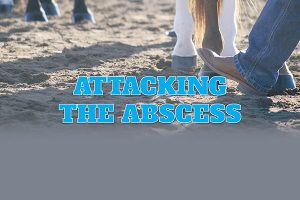Attacking The Abscess
Click here to read the complete article
322 – March/April, 2023
It’s perplexing
Just last night, you had a successful ride on your horse. Just last night you were walking out of the pen patting his neck and excited for the show to start tomorrow. But now, as you go to pull him out of his stall for a bath, he’s lame.
We’re talking three-legged, no weight to put on that front leg, worry lines creasing his eyelids and tears streaming down your face lame.
What in-the-full-wheelbarrow-of-manure happened?
A is for Abscess
The answer to that question can be one of two things: an abscess or a fracture in the leg. Those are the two things that can cause so much pain so quickly. But take a deep breath: Most likely, it’s an abscess in the hoof.
The biggest telltale sign that your horse is suffering from an abscess is the sudden onset of pain, and it’s a level of pain that is quite high. The stoic horse can’t cover up this pain reaction.
“The pain is coming from the laminae of the foot,” says Jim Hassinger, DVM, owner of Hassinger Equine Service in Aberdeen, North Carolina. “That is a very sensitive area of the hoof. There’s a good bit of pressure that the gas releases from the bacteria associated with the abscess, so it is a very painful thing for the horse to go through.”
An abscess is the collection of bacteria located between the laminae and the sole of the hoof or the hoof wall. (The laminae are the tissue layers that bond the hoof capsule to the coffin bone, according to the American Association for Equine Practitioners website.) It’s very similar to a zit on a human’s face–bacteria collect under the outer layer of the skin, where it builds up and out of the face, creating pressure (and sometimes pain). In both cases, the bacteria can create a pus. In both cases, it’s not fun to deal with when they occur.
And, just like a zit on your face, while the sign of the abscess seems to suddenly “pop up,” it’s something that has most likely been brewing for a bit of time.
Symptoms of an Abscess
Click here to read the complete article
322 – March/April, 2023











